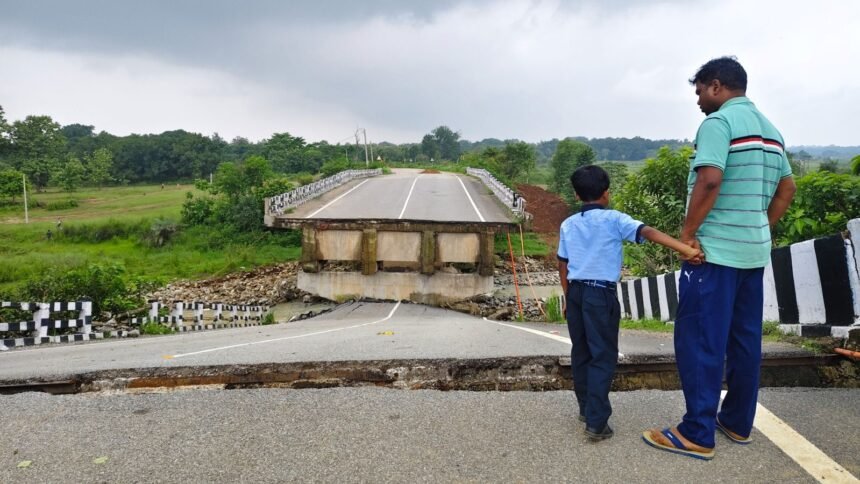For 20 days now, Pawan Singh has been following a new and treacherous route while taking his three children to school. Each day, they walk four kilometres to the “broken bridge”, then down a mud path to the bank of the river Banai. From here, he hoists one child on his shoulder, wades through the river, drops the child on the other side, and then comes back for the others.
Exhausted, he returns home, only to repeat the process hours later when it’s time to bring them home.
“It has become a daily battle,” Singh, a resident of Khunti district’s Angrabari, tells The Indian Express. “I cross the river 12 times a day.”
 Jharkhand has been witnessing heavy rain in the past month, seeing its wettest June in 11 years. The state saw a whopping 348.9 mm of rainfall — 84 per cent more than the monthly average of 189.5 mm.
Jharkhand has been witnessing heavy rain in the past month, seeing its wettest June in 11 years. The state saw a whopping 348.9 mm of rainfall — 84 per cent more than the monthly average of 189.5 mm.
Singh isn’t the only one having to cross the river like this. For the last 20 days, many residents living around the river have followed a similar routine after heavy rain caused a bridge over it to split right in the middle, leaving a 25-foot gap.
The bridge was part of the National Highway-75, connecting Khunti to Simdega and further to Odisha. The incident, on the morning of June 19, has left hundreds stranded on both sides, with incessant rain and the swelling river aggravating the situation and making the crossing deadly.
“Water now rises to our chest, but we don’t have a choice,” Singh says. “The alternate route is a 15-km detour through Chatkanda and Kunjla Mod. It’s just not feasible.”
 The heavy rain caused the bridge, constructed in 2007 at an estimated cost of Rs 1.25 crore, to split into two. It also caused one part of the road to sink, making it hang dangerously.
The heavy rain caused the bridge, constructed in 2007 at an estimated cost of Rs 1.25 crore, to split into two. It also caused one part of the road to sink, making it hang dangerously.
Jharkhand has been witnessing heavy rain in the past month, seeing its wettest June in 11 years. The state saw a whopping 348.9 mm of rainfall — 84 per cent more than the monthly average of 189.5 mm.
Story continues below this ad
The heavy rain caused the bridge, constructed in 2007 at an estimated cost of Rs 1.25 crore, to split into two. It also caused one part of the road to sink, making it hang dangerously.
As a result of the collapse, traffic has been diverted through another route, the NH-143. But for villagers, this change comes at a steep price. For one thing, it means spending more on transport.
“Earlier, the school auto used to charge Rs 500 per month, but now it’s Rs 1,000. Not everyone can afford that,” another parent, Dashrath Mahto, says.
 As a result of the collapse, traffic has been diverted through another route, the NH-143. But for villagers, this change comes at a steep price. For one thing, it means spending more on transport.
As a result of the collapse, traffic has been diverted through another route, the NH-143. But for villagers, this change comes at a steep price. For one thing, it means spending more on transport.
For another, the alternate route is frequently used by heavy vehicles, making it more dangerous for pedestrians, the residents say.
Story continues below this ad
With the bridge now split in half, no school buses come to the area, forcing students from the nearby Rodo, Sungi, Angrabari, Bichana, Saridkel, Japud, Jaltanda, and Gamhariyam villages to take the more dangerous route – the river.
“We leave home at 6:30 am and reach the school some 4 km away around 7:30 am. But on days the water levels are high and the currents are strong, we’re forced to take a longer route. That’s 30 kilometres up and down,” Mahto, who takes turns with another parent to drop the kids to school, says.
Locals had initially come up with a different solution: they had placed a bamboo stepladder from the sunken part of the road up to the other side of the bridge. A video that went viral soon after the collapse showed some older schoolchildren climbing the ladder, which wobbled dangerously under their weight.
“We used it to carry our children on our shoulders and climb up,” Mahto says. “Later, the police and district administration ordered its removal, saying it was too risky. But isn’t the situation even more dangerous now?”
Story continues below this ad
Local residents claim they have approached the administration several times. On its part, Khunti Deputy Commissioner R Ronita says that the Pelol bridge collapse was caused by “extreme rainfall”.
“Khunti received over 360 mm of rain in just three days — well above the district’s average. The structure split in the middle, making it unsafe for movement… Tender process for repair is underway, and work is expected to begin soon,” she says.
“It is not a National Highway, but part of State Highway-3 (SH-3). Therefore, its construction and maintenance fall under the Road Construction Department (RCD) of the Jharkhand government, specifically under the PWD Khunti Division,” Mukund Attarde, the project director of the National Highways Authority of India, Jharkhand, tells The Indian Express.
Officials at the PWD division did not respond to calls and messages seeking a comment.








